The following are the 10 most common mistakes I see people making while walking their dogs, assuming a goal is to stop the dog from pulling.
Of course, I have made all of these mistakes as well. Many times.
Mistake #1: Walking in a straight line.
Most of us want to walk in a somewhat straight path to get to a certain destination or to complete a certain “route.”
However, when you’re training your dog to heel or walk on a loose leash, this makes it way too tempting for him to pull forward in an attempt to get to some random scent or object as fast as possible.
Solution: Mix it up.
Talk to your dog in a happy voice and walk in all sorts of random patterns.
Zig-zag. Walk around trees. Randomly turn around. Walk in tight circles. Walk in huge circles (like in an obedience class). Speed up. Slow down. Whatever.
Do this while popping treats at your dog’s face when he looks at you. At the very least, change up your route every day so it’s not so predictable.
Mistake #2: Walking too slowly.
Dogs are generally much faster than us. We move at a painfully slow pace, so when they’re barging ahead, they’re generally not doing so to be “dominant.” They’re just being dogs.
Solution: Jog, walk faster or run with your dog for at least part of the time.
I agree that dogs should learn to walk at our pace. But while they’re still learning, we can make it easier by walking faster.
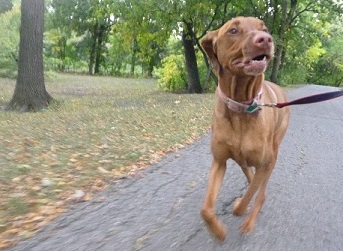
Mistake #3: Tightly gripping the leash.
Most dogs will naturally pull harder if the leash is tight. It’s a natural reaction as they try to free themselves from the tension, right?
Solution:
Instead of holding the leash as tight as possible, hold it loosely. Don’t wrap it around your hand or wrist. Hold it really loosely, like with two fingers in your left hand with the slack held loosely in your right. When your dog pulls, simply turn and walk the other way.
Mistake #4: Not using the right treats.
And I mean treats! Not dry Milkbones, but hot dogs, real hamburger, pieces of chicken, etc.
(It doesn’t hurt to train your dog when he’s a little hungry, either.)
I find that most dogs respond really well to the soft, training treat called Zuke’s minis. I also recommend a treat pouch to hold the treats while you work on training.
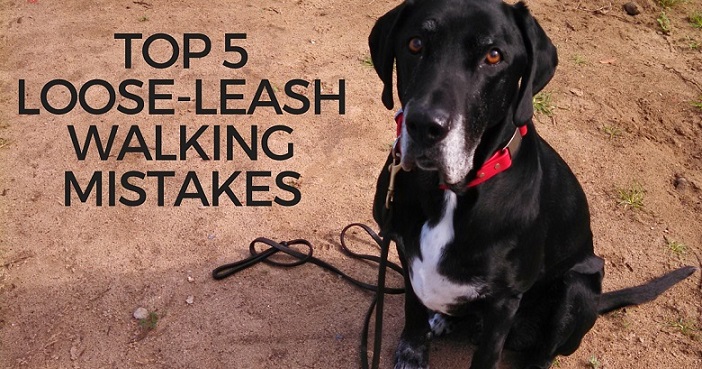
Mistake #5: Getting frustrated with your dog!
It’s super frustrating when a dog is pulling and making those awful choking and wheezing sounds. It’s also embarrassing!
I’ve been there and I remember feeling like people were judging me for being unable to control my dog.
Solution: Stay positive, and don’t worry what others think.
Most people don’t really care how someone else’s dog is or isn’t walking. And if they do? So what!
If you find yourself getting frustrated often, I highly suggest buying a training collar that will give you more control. Walking your dog should be fun, not stressful.
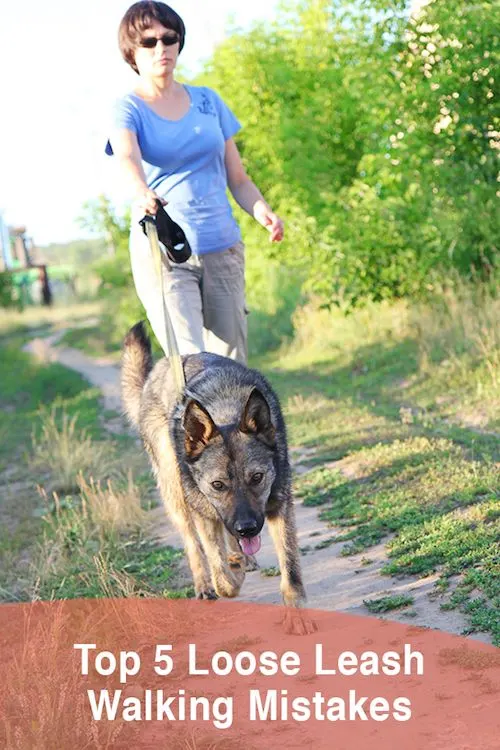
I suggest a prong collar, a Gentle Leader or a no-pull harness.
For me, having the right collar makes all the difference and helps me keep my sanity, especially while the dog is still learning.
See our post: Best dog training treats
Mistake #6: Using the wrong tools
Tools like retractable leashes, flat collars and regular harnesses tend to enable pulling because they don’t offer us any control.
They should only be used on dogs who have impeccable leash walking skills or who have slowed down a lot due to their age. Harnesses with leash attachment points on the back also work well when you take your dog running.
Solution:
Replace retractable leashes with a sturdy 6 ft leash made of nylon or leather. Use training collars like a martingale collar, head collar, slip collar or prong collar instead of the flat collar.
If you prefer walking your dog on a harness, use a no-pull harness that has a front attachment for the leash.
Mistake #7: Using the training collar wrong
If you’re using a training collar in the wrong way, it won’t be effective and/or it will hurt your dog. For example, if the prong collar is used incorrectly, it can damage your dog’s throat area, and you won’t be able to redirect your dog on a loose head collar.
Solution:
Make sure to understand how to use the different training collars before you use them on your dog.
The prong collar needs to sit snuggly but comfortably right behind your dog’s ears and not around his throat. It can’t be too loose or it won’t stay up there. You’ll likely have to remove or add some links from/to the collar to get the perfect fit for your dog.
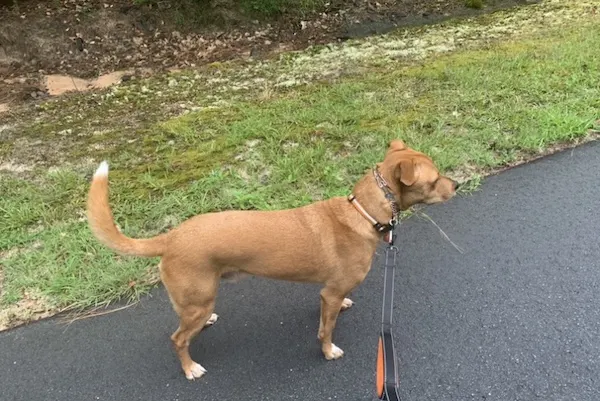
For the head collar, such as a Halti or Gentle Leader, you’ll need to adjust it so that you can only fit one finger underneath the neck section of the strap.
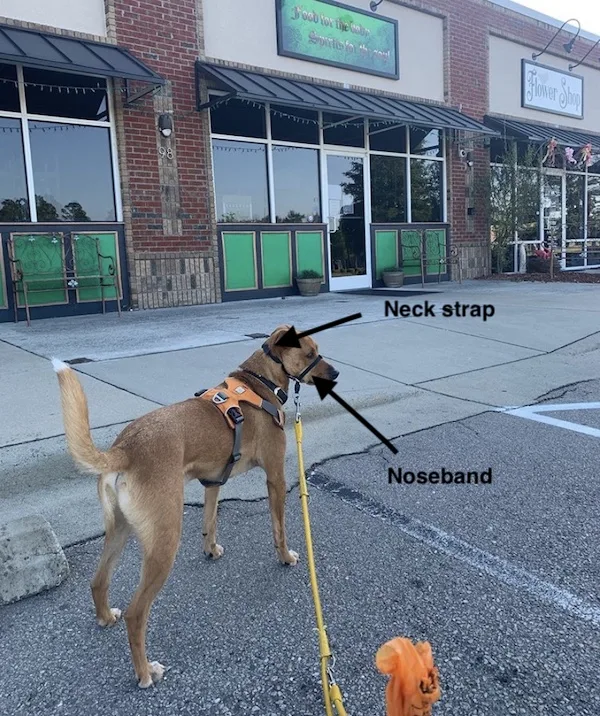
Mistake #8: Working in an area that is too distracting
Your dog won’t be able to concentrate on what you ask him to do if you’re working in an area that’s too distracting for him.
Solution:
Start working in a very low distraction area and slowly work your way up from there.
For example, start asking your dog to obey your commands like sit, down, stay, and come in the comfort of your home.
Once he reliably listens to you, take things up a notch and practice in an area outside that is a little more distracting. This could be your fenced-in backyard, front yard, or maybe your driveway or open garage.
You could work with him on an extra long leash that’s 15-30 ft long. That way, you’re practicing in a controlled training environment where you can always reel your dog back in if he gets distracted by something or someone.
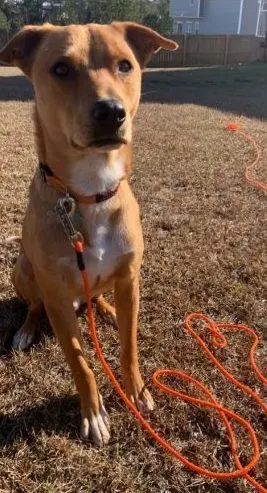
Once he’s mastered this new level of distraction, increase it again by practicing obedience on walks through your neighborhood. After that, you can really take it up a notch and practice on walks in local parks and urban environments.
Tip: Don’t forget to bring high-value training treats!
Mistake #9: Not being consistent with your dog
Dogs who receive different messages from different people have no clue when they’re allowed to do what. These inconsistencies will make training your dog really hard, if not impossible.
Solution:
Make sure that everyone who interacts with your dog is on the same page as far as leash training and overall behavior is concerned.
This goes for your immediate family like spouse and kids, but also for visitors, house guests, and dog walkers or pet sitters.
For example, if your dog is allowed to behave like a maniac before he heads out on a walk with your spouse, but you expect him to sit calmly and politely right by the front door when you walk him, he’ll be confused.
The same applies for walking inconsistencies. You can’t expect him to know that he’s allowed to pull ahead when your boyfriend walks him, but that you don’t allow that type of behavior. Instead, you expect your pup to walk right next to you.
Mistake #10: Not training your multiple dogs separately
It’s impossible to achieve a variety of leash training goals for your multiple dogs when you’re trying to do it all at once. That’s why dog obedience classes always require one handler per dog.
Solution: Train your multiple dogs separately.
If they all pull on leash, you’ll have to take turns walking them or recruit someone to walk with you. Otherwise, you won’t be able to effectively correct your dogs’ unwanted behaviors.
For example, if one dog pulls you towards a squirrel while the other one lunges at a fellow dog walker passing you, you’ll have to choose which one to correct first. Yelling and yanking on both leashes will only teach your dogs that chaotic behavior is OK. It won’t teach them to pay attention to you and to stop pulling.
When you’re out walking your dog, reward him with verbal praise like YES, GOOD BOY/GIRL and a high-value treat whenever he looks at you and makes eye contact. Also frequently change the direction you walk in.
That teaches him to stay close to you and to check in with you on a regular basis. Ultimately, it will make him a lot less interested in other dogs and people you encounter on your walks.
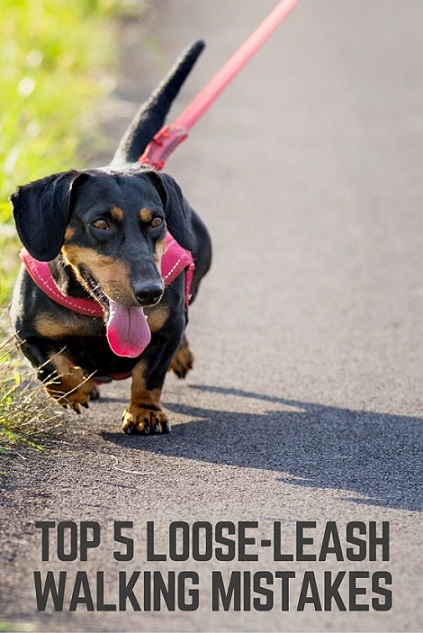
Other tips that can help:
Stop moving if the dog pulls.
Blog reader Margaret P. said she can’t walk very fast due to arthritis in her knees. She found that to stop her dog from pulling it worked to stop dead in her tracks, refusing to go any further.
“Generally she comes back to my side and looks up at me at which time I start to walk forward again. She has learned that in order to keep moving, she must be close to my side and not pulling me. It took awhile, but she got the message.”
Using your other dog as a teacher.
Karen B. said she taught her boxer mix to walk nicely on a leash by using her older dog to help the new guy gain confidence. While her boxer mix was scared to walk on concrete at first, he eventually learned to walk nicely.
“Now that he’s older, he’s running 3 to 5 miles every other day with me. He loves it.”
I would also suggest:
– Making sure the dog gets off-leash play at least a few times per week to burn energy.
– Using a dog backpack to help burn some energy and give him something to focus on other than pulling.
Do you have any tips to teach a dog to stop pulling?
Let me know if you do!
Barbara Rivers contributed to this article. She writes regularly for That Mutt and is a blogger, raw feeder and dog walker. She maintains the blog K9s Over Coffee.

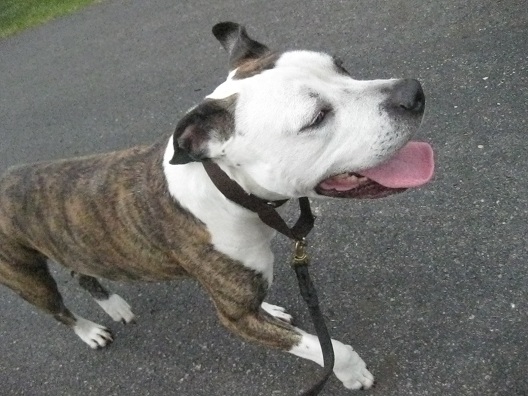
The Essential Beginner'S Guide To Leash Training Your Dog - K9 Secrets
Friday 2nd of February 2024
[…] Inconsistent training – Training needs to be an everyday routine for your dog to understand what’s expected. Being inconsistent with training, rules and rewards will only confuse your dog and delay progress. Stick to scheduled daily training. [2] […]
What Is The 3-3-3 Rule of Adopting a Rescue Dog? - NimasPark
Saturday 11th of March 2023
[…] to dog walking […]
What Is The 3-3-3 Rule of Adopting a Rescue Dog? | VirarNews: Latest Virar News and Updates at Virality.bid
Friday 10th of March 2023
[…] to dog walking […]
Kim Chappell
Sunday 6th of October 2019
Great article, thank you. I would like to add that I use and recommend the Transitional Leash by K9Lifeline. It is a type of head halter, but it has the leash part coming off the BACK of the dog's head-not under the dogs jaw like a Gentle Leader. I've found this is more effective and often more accepted by the dog than other head halters. I no longer recommend the "no pull" harnesses, as they have been found to cause joint and muscle damage because they restrict the movement of the dog. The dog backpack is a great idea, be sure to get one that positions the weight over the dog's shoulders, not the dog's back. I use half full bottles of water in each side of the pack, the sloshing water keeps the dog's attention better as he has to concentrate on his balance with the sloshing water, and not worry so much about his surroundings.
Lindsay Stordahl
Monday 7th of October 2019
I agree that no-pull harnesses are not ideal, just as head halters and all types of collars are not ideal. I guess we all just have to pick what's best for our own dogs in each circumstance. I mix it up a lot with the types of collars and harnesses I use for different situations with my extremely excitable strong puller.
Meg Sheridan
Sunday 6th of October 2019
I used a Halti head collar with my Malinois on walks. No pulling at all - control the head, control the dog. I also bring "walk" treats. These are special treats only for walks. It helps her stay focused on me and not distractions. Fortunately, my Mal is food and toy motivated so we don't have too many issues with training.